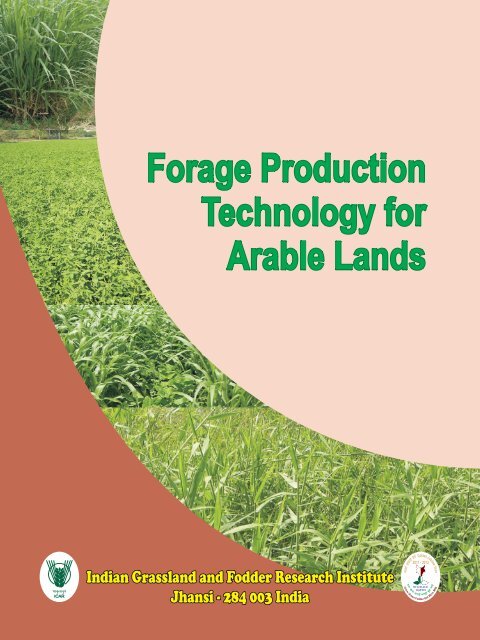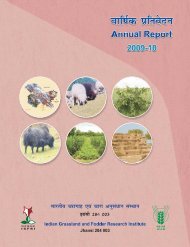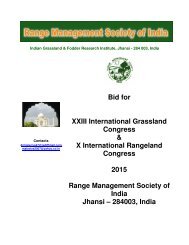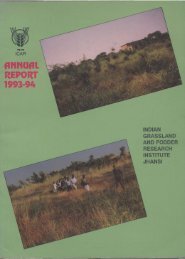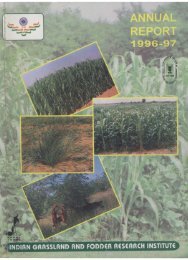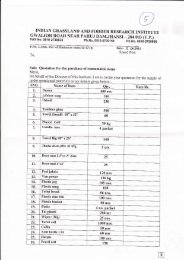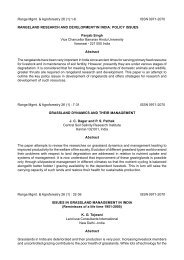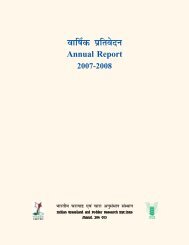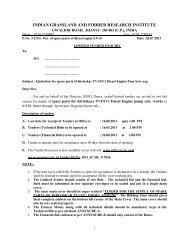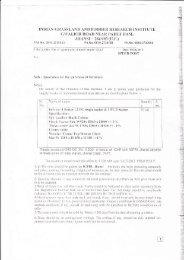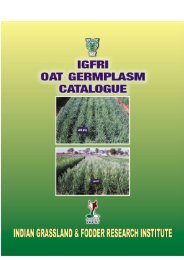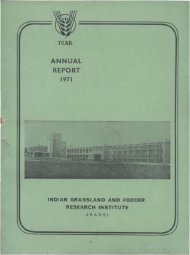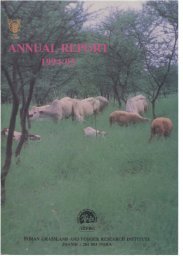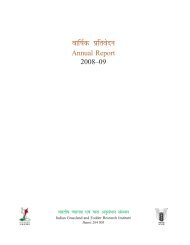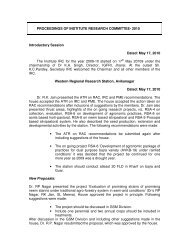Forage Production Technology for Arable Lands - Indian Grassland ...
Forage Production Technology for Arable Lands - Indian Grassland ...
Forage Production Technology for Arable Lands - Indian Grassland ...
Create successful ePaper yourself
Turn your PDF publications into a flip-book with our unique Google optimized e-Paper software.
ICAR
FOREWORDEnhancing <strong>for</strong>age security is must <strong>for</strong> ensuring sustained developmentof the livestock sector. In order to enhance <strong>for</strong>age productivity andsustained natural resource base, propagation of the technical knowhowand recent advances therein are essential to harness the potentialof the production system in different niches by knowledge basedinterventions in a holistic way. Such approach will enable to produceenough from per unit area per unit time to meet the growing fodderfooddemand in ever changing scenario. Division of Crop <strong>Production</strong> was established atthIGFRI in mid sixties of the 20 century with mandate of developing suitable fodderproduction systems <strong>for</strong> arable lands in irrigated and rainfed situations and problematicareas with an emphasis on efficient use and management of resources. This technologybulletin developed based on the several research findings of the division over past fiftyyears is intended to the <strong>for</strong>age resource development and trans<strong>for</strong>mation of the livestocksector.I am happy that authors have made tremendous ef<strong>for</strong>t in bringing this document andsummarizing the work in technology <strong>for</strong>m. I appreciate their ef<strong>for</strong>t and congratulatethem <strong>for</strong> this accomplishment. I am sure this in<strong>for</strong>mation will be useful to different stakeholders involved in <strong>for</strong>age resource development and livestock production.(P K Ghosh)Director
PREFACEAvailability of quality feed and <strong>for</strong>ages has been considered as the major bottleneck inharnessing the potential of the livestock sector in India. Cultivated fodder is limited toless than 4.5 per cent of the total cropped area. At present, country faces a net deficit of63% green fodder, 24% dry crop residues and 64% feeds. Projections show a furtherincrease in demand by 2025 due to changing feeding and more dietary reliance onlivestock and its products. Only way to meet the fodder needs is to look <strong>for</strong> increasedproductivity per unit land area and also through integration of fodder crops in thecropping system. Crop <strong>Production</strong> Division at IGFRI, took steps <strong>for</strong>ward and developedtechnologies <strong>for</strong> the <strong>for</strong>age intensification and its integration with the existing croppingsystems to harness the potential of <strong>for</strong>age resource development in different agroecosystems.This compilation is made primarily to provide up to date technology, fitting in the nichesof different resource base. Attempt has been made to present important <strong>for</strong>ageproduction technologies suitable <strong>for</strong> irrigated and rainfed conditions. This compilationcontains four sections dedicated to the rain fed, irrigated, problem soil and new niches.Each section is dealing with the <strong>for</strong>age production technology developed <strong>for</strong> bestutilization of the resource base and neutralizes the challenges present in the targetedareas. A special section “new niche <strong>for</strong> <strong>for</strong>age production” is having listing of theopportunity of <strong>for</strong>age resource development existing in the non conventional areas.Ef<strong>for</strong>ts have been made in presenting all the in<strong>for</strong>mation available in a clear and concisemanner. Any faux pas, if observed, may be due to chance only. Authors will appreciatecomments and suggestions <strong>for</strong> further improvement of the compilation. We gratefullyexpress our thanks to the scientists and staffs who have contributed in the preparation ofthe manuscript. We also express our thanks to Dr P. K. Ghosh, Director, IGFRI, <strong>for</strong> hisguidance and encouragement in bringing out this publication.Authors
CONTENTSForewordPrefaceiii1 Introduction 12 <strong>Forage</strong> production systems in irrigated lands2.1 Intensive <strong>for</strong>age production systems2.2 Food-fodder production systems2.3 <strong>Forage</strong>s in non- food crop production system2.4 <strong>Forage</strong> production during lean period2.5 <strong>Forage</strong> production under orchards and grooves3 <strong>Forage</strong> production systems in rainfed lands3.1 Round the year <strong>for</strong>age production system3.2 Seasonal crop based <strong>for</strong>age-food production system3.3 Perennial crop based <strong>for</strong>age-food production system4 <strong>Forage</strong> production in problem soils4.1 <strong>Forage</strong> production in salt affected soils4.2 <strong>Forage</strong> production in acid soils4.3 <strong>Forage</strong> production in calcareous soils4.4 <strong>Forage</strong> production in waterlogged soils5 <strong>Forage</strong> production systems in new niches5.1 Non-competitive <strong>for</strong>age production system5.2 <strong>Forage</strong> production in rice ecosystem5.3 Non conventional <strong>for</strong>ages
ACKNOWLEDGEMENTWe express our deep sense of gratitude to the Director(s) IGFRI, members QRT andRAC <strong>for</strong> providing encouragement and guidance to compile the "Forge <strong>Production</strong><strong>Technology</strong> <strong>for</strong> <strong>Arable</strong> <strong>Lands</strong>". Present bulletin has been developed from the researchfindings of the Agronomy/Soil/Crop production Division over last 50 years. We arethankful to all Heads and their dedicated team of scientist since inception of the Institute,whose contributions lead to the advancement of the science of <strong>for</strong>age production andresource conservation. Some in<strong>for</strong>mation also has been drawn from the publications ofthe AICRP(FC), we also acknowledge the same.The assistance rendered by field and laboratory staff is duly acknowledged. We alsoacknowledge the help given by present team of scientists and staff of Crop <strong>Production</strong>Division <strong>for</strong> their critical input in preparation of manuscript. Last but not the least; weplace on record our sincere thanks to publication committee <strong>for</strong> timely bringing out thepresent bulletin.Authors
1. INTRODUCTIONLivestock sector is playing crucial role in the overall growth of agriculture sector andgross domestic product of the country. The projected target <strong>for</strong> agriculture growth in fiveyears plan cannot be met without substantial growth in this sector. Deficit of the feed andfodder availability of the desired quality is major bottleneck restricting growth at desiredlevel. It has been established that the cost of milk production can be significantly loweredby improving feeding system based on green fodder and replacing ingredients ofconcentrate with leaf meal and enriched complete feed block. But, cultivated fodder islimited to less than 4.5 per cent of the area under cultivation in country. Present areaunder fodder crops in India is around 8.6 million hectare. Availability of fodder resourceshas been estimated to be around 60% in nineties had further reduced to around 50% of thetotal requirement. Further increase in the acreage of the fodder crops is not possible dueto increased competition between various land uses <strong>for</strong> the cultivable land. Only way tomeet the fodder needs of livestock is to look <strong>for</strong> increased productivity per unit land areaand also through integration of fodder crops in the cropping system. This neededbreakthrough in increasing productivity and sustaining availability of green <strong>for</strong>ages ispossible through tailor- made technological intervention in specific niches. Suchprospect offers opportunity <strong>for</strong> the integration of the fodder based production technologybased on SWOT analysis of its resource base. Since long, need <strong>for</strong> a compilation of<strong>for</strong>age production technology suitable <strong>for</strong> the arable land encompassing the details of therequired ingredient of the production system, clientele of the specific technology and itspossible impact on the socio-economic status was felt at different <strong>for</strong>um.In this background, present technology bulletin was developed based on the researchbreakthrough made at IGFRI over last 50 years <strong>for</strong> solving the production andproductivity related constraints in different production systems. The key issues coveredin the compilation pertain to the <strong>for</strong>age production technology <strong>for</strong> irrigated, rainfed,problem soils and <strong>for</strong>age production from new niches. Technologies listed are developed<strong>for</strong> clientele of different resource base e.g. intensive fodder production technology istailored to meet out the requirement of the commercial dairy farm and farmers of themilkshed having assured irrigation facility and availability of other production inputs ,while food-fodder or non competitive land use system focus on the small and marginalfarmers with limited resources. A special section on the <strong>for</strong>ages from new niches and nonconventional sources provide the opportunity <strong>for</strong> technological backup to explore theseareas <strong>for</strong> diversification and expansion of <strong>for</strong>age resource development.<strong>Forage</strong> <strong>Production</strong> <strong>Technology</strong> <strong>for</strong> <strong>Arable</strong> <strong>Lands</strong>1
2. FORAGE PRODUCTION SYSTEMS IN IRRIGATED LANDSIn India, cultivated fodder is limited to less than 4.5 per cent of the area under cultivation.Present area under fodder crops in India is around 8.6 million hectare. Further increase inthe acreage of the fodder crops is not possible due to increased competition betweenvarious land uses <strong>for</strong> the cultivable land in the country. Only way to meet the fodderneeds of livestock may be possible by increased productivity per unit land area and alsothrough integration of fodder crops in the existing cropping systems.2.1. Intensive <strong>for</strong>age production systemsConsidering the needs of dairy farmers and small livestock keepers <strong>for</strong> round the yearsupply of green fodder producing maximum <strong>for</strong>age from a small piece of land,overlapping cropping system wasdeveloped at IGFRI, Jhansi. Thissystem consisted of raising berseem,inter-planted with hybrid Napier inspring and intercropping the interrow spaces of the grass with cowpeaduring summer after the final harvestof berseem. In this productionsystem, 3-4 fodder crops arecultivated on same piece of land in acalendar year <strong>for</strong> continuous supplyof fodder to dairy animals throughout the year. It is temporal and spatial intensification ofcropping system. It includes intercropping, mixed cropping and sequential cropping.Adaptation area: It is useful <strong>for</strong> those areas where dairy has come up at commercialscale especially in peri urban and milkshed areas.Components /input requirements:Well drained and fertile land, improvedvarieties, rooted slips of hybrid napier,seed of leguminous crop, assuredirrigation facility, sufficient fertilizers,organic manures, pesticides, tillageimplements, farm labourers, etc.System description: Under irrigatedsituations, intensive <strong>for</strong>age crop2 <strong>Forage</strong> <strong>Production</strong> <strong>Technology</strong> <strong>for</strong> <strong>Arable</strong> <strong>Lands</strong>
sequences and/or intercroppingsystem have been identified <strong>for</strong>increasing herbage yield, improving<strong>for</strong>age quality, affecting fertilizereconomy and ensuring better landutilization. Intensive <strong>for</strong>ageproduction systems aims at efficientutilization of land and other inputs<strong>for</strong> maximum fodder production perunit area per unit time. These crop sequences are tailored with an objective of achievinghigh yield of green nutritious <strong>for</strong>age and maintaining the fertility of the soil. Underassured irrigation conditions of central India, multiple crop sequences like sorghum +cowpea - berseem + mustard - maize + cowpea and sorghum (multicut) + cowpea -berseem + mustard are promising. Overlapping cropping systems has been developedinvolving seasonal and perennial <strong>for</strong>age crops like Guinea grass and Napier bajra hybrid(NB hybrid) intercropped with cowpea during zaid and kharif and berseem in Rabi, hasthe capability of providing round the year fodder to the dairy animals (Table-1). In thiscropping system hybrid Napier could be successfully replaced with relatively soft andpalatable perennial grasses like setaria and Guinea. In humid and sub-humid climate,setaria and Guinea grass per<strong>for</strong>m better. Similarly, berseem can be replaced by Lucernein western part of the country <strong>for</strong> utilization of interspaces. Most promising croppingsystems recommended <strong>for</strong> different agro-climatic and soil conditions and their <strong>for</strong>ageyields potential are given in table 2.Table 1:Potential intensive <strong>for</strong>age crop rotations under irrigated conditions <strong>for</strong>semi arid region of IndiaCrop rotationsGreen fodderyieldDry matteryield(t/ha/year) (t/ha/year)NB hybrid + (Cowpea - Berseem + Mustard) 273.1 44.3Sorghum (multi cut) - Turnip - Oat 190.1 37.4Sorghum + Cowpea - Berseem + Mustard - 180.5 33.3Maize + CowpeaSorghum (multi cut) + Cowpea - Berseem + Mustard 172.0 32.3<strong>Forage</strong> <strong>Production</strong> <strong>Technology</strong> <strong>for</strong> <strong>Arable</strong> <strong>Lands</strong>3
Table 2. Intensive <strong>for</strong>age crop rotations <strong>for</strong> different agro-climatic zones of IndiaCrop rotation / climate & soilGreen fodderyield(t/ha/year)Hill and Northern RegionSub-temperate, Moist, Red soil1. Maize + Cowpea - Lucerne + Oats - Mustard 852. NB Hybrid + Velvet bean - Berseem + Mustard 123Tarai, Red & yellow soil1. Maize + Cowpea - Toria - Oats 1772. NB Hybrid + Berseem - Cowpea 121Semi-arid, Sandy loam soil1. NB hybrid + Berseem 2122. NB hybrid + Lucerne 176Central and Western RegionSemi-arid, Red soil1. NB hybrid + Cowpea - Berseem + Mustard 2552. Sorghum + Cowpea - Berseem + Mustard - Maize + Cowpea 176Sub-humid, Black soil1. NB hybrid + Cowpea - Berseem 1762. Sorghum + Cowpea - Berseem + Mustard - Sorghum + Cowpea 169Semi-arid, Black soil1. NB hybrid + Cowpea - Lucerne 253Eastern RegionSub-humid, Red acidic soil1. Pearl millet + Cowpea - Maize + Cowpea - Oats 1032. Maize + Cowpea - Sorghum + Cowpea - Berseem + Mustard 96Sub-humid, Alluvial soil1. Maize + Cowpea - Dinanath grass - Oats 1312. Maize + Rice bean - Berseem + Mustard 112Humid, Acidic soil1. NB hybrid (perennial) 1062. Maize + Cowpea - Maize + Cowpea - Maize + Cowpea 85Southern RegionSub-humid, Black soil1. NB hybrid + Lucerne 2252. Sorghum + Cowpea - Maize + Cowpea - Maize + Cowpea 111Humid, Red soil1. Guinea grass in Coconut plantation 1352. Congo signal gram in Coconut plantation 754 <strong>Forage</strong> <strong>Production</strong> <strong>Technology</strong> <strong>for</strong> <strong>Arable</strong> <strong>Lands</strong>
Brief package of practice: In intensivecropping system timeliness in all theagricultural operations and sufficientavailability of all the necessary inputsplay an important role. Brief package ofpractice of component crops <strong>for</strong> CentralIndia have been given in table-3.Table 3: Package of practices of important component cropsCrops and theirSowing/Seed rateNo. ofFertilizerHarvestingvarietiesplantingand spacingirrigationsmanagementscheduletime(cm)I. NB hybrid + (Cowpea - Berseem + Mustard)NB hybrid: IGFRI-6Mid20000DuringBasal:1 st cut: 75 –& 10, NB-21February –rooted slipsspring &50+50+50 kg80 days afterJulyplanted atsummer 8-NPK/haplanting100 x 50 cm9Top dressing:(DAP)spacing50+50+50+50Subsequentkg N/ha aftercuts: 30– 40each cutdays afterprevious cutharvesting(DAH)Cowpea: EC-4216,April –20-25 kg ,Same asNo separateOnly one cut:Kohinoor (IGFRI-S-May whentwo linesNB hybridfertilization60-65 days450), BL-1 & BL-2berseembetween tworequiredafter sowingcroprows of N-B(DAS)harvestedhybridBerseem: Mescavi,October25 kgTotal 12-Basal: 20+801 st cut : 50 –Wardan, BB-2, BB-3berseem +15: 8-10kg NP/ha55 DAS+ Mustard: Chinese1.5- 2.0 kgdaysSubsequentcabbage, Japanesemustard,intervalcuts: 30 – 35<strong>Forage</strong> <strong>Production</strong> <strong>Technology</strong> <strong>for</strong> <strong>Arable</strong> <strong>Lands</strong>5
apebroadcast inmuddedfieldduringAutumnand 12-15daysintervalduringSpringII. Sorghum (multi cut) - Turnip – OatSorghum: MP chari, March- 35-40 In summerSSG-59-3 (multicut) April kg/ha, 25 8-10 dayscm apart interval &rows inmonsoondependingon rainsTurnip: Snowball, Last week 5-6 kg/ha, One lightPusa Chandrima, of On ridges irrigationPurple TopSeptember with 30 x 10 immediatecm spacing aftersowingandsubsequentirrigationat 15 daysintervalOat: JHO-822, Kent, Third to 100 kg/ha, First afterJHO-851 & 861, last week sown in 25 20 daysUPO-94of October cm apart afterFor multicut(4 cut),basal:60+60+60kg NPK/haand topdressing:50+50+50kg N/haafter eachcut10-12 tFYM/ha,60+30+30kg NPK/haBasal:60+50 kgNP/ha; topDAH1 st cut: 55-60DASSubsequentcuts: 35-40DAHAt 65-70DASSingle cut: 75DAS (50 %flowering)6 <strong>Forage</strong> <strong>Production</strong> <strong>Technology</strong> <strong>for</strong> <strong>Arable</strong> <strong>Lands</strong>
ows sowingandsubsequentirrigationsat 12-15daysintervaldressing: 30kg N/haafter eachcutIII. Sorghum + Cowpea - Berseem + Mustard - Maize + CowpeaSorghum: PC-6 & 9 June - July 20-25 kg/ha Depending 60+45 kg(Single cut), MP chari,sorghum + on rains NP/ha asSSG-59-3 (multicut) +25- 30 kg/habasal doseCowpea: EC-4216,cowpea, 25Kohinoor (IGFRI-S-cm apart450), BL-1 & BL-2rows in 2:2row ratioBerseem: Mescavi, First to 25 kg Total :8- Basal: 20 +Wardan, BB-2, BB-3 third week berseem + 10 days 80 kg NP/ha+ Mustard: Chinese of October 1.5- 2.0 kg intervalcabbage, Japanesemustard, duringrapespacing of Autumn20 x20 cm and 12-15ordaysbroadcasting intervalin mudded duringfield SpringMaize: African tall, March – 25-30 kg/ha 7-8 Basal:Ganga safed 2, J- April & maize + 25- irrigations 60+30 kg1006, Jawahar June - July 30 kg/ha at 8-10 NP/hacomposite, Vijay +cowpea, 25 days TopCowpea: EC-4216,cm apart interval dressing: 30Kohinoor (IGFRI-S-rows in 2:2kg N/ha450), BL-1 & BL-2row ratio30 DAS<strong>Forage</strong> <strong>Production</strong> <strong>Technology</strong> <strong>for</strong> <strong>Arable</strong> <strong>Lands</strong>Multi cut: 1 stcut at 65DAS,Subsequentcuts at 30 –40 DAH1 st cut: 55-60DASSubsequentcuts: 35-40DAH1 st cut : 50 –55 DASSubsequentcuts: 30 – 35DAH60-75 DAS7
IV. Sorghum (multi cut) + Cowpea - Berseem + MustardSorghum: MP chari,SSG-59-3 (multicut) +Cowpea: EC-4216,Kohinoor (IGFRI-S-450), BL-1 & BL-2June - July 20-25 kg/hasorghum +25- 30 kg/hacowpea, 25cm apartrows in 2:2row ratioDependingon rainsBerseem: Mescavi, First to 25 kg Total 12-Wardan, BB-2, BB-3 third week berseem + 15: 8-10+ Mustard: Chinese of October 1.5- 2.0 kg dayscabbage, Japanesemustard, intervalrapespacing of during20 x20 cm Autumnorand 12-15broadcasting daysin mudded intervalfield duringSpring60+45 kgNP/ha asbasal doseBasal: 20 +80 kg NP/ha1 st cut: 55-60DASSubsequentcuts: 35-40DAH1 st cut : 50 –55 DASSubsequentcuts: 30 – 35DAHOutput and economics: The crop rotations, NB hybrid + (cowpea - berseem + mustard)and sorghum (multi cut) + cowpea - berseem + mustard have higher B: C ratio. Thecomparative output has been given in table-4.Table 4: <strong>Production</strong> economics of different crop sequencesCrop rotationsB:C ratioNB hybrid + (Cowpea - Berseem + Mustard) 2.41Sorghum (multi cut) - Turnip - Oat 1.48Sorghum + Cowpea - Berseem + Mustard - Maize + Cowpea 1.67Sorghum (multi cut) + Cowpea - Berseem + Mustard 1.948 <strong>Forage</strong> <strong>Production</strong> <strong>Technology</strong> <strong>for</strong> <strong>Arable</strong> <strong>Lands</strong>
Specific benefits: This system ensures increased herbage yield, improvement in <strong>for</strong>agequality, regular supply of green fodder, efficient utilization of inter row space,improvement in physico-chemical properties of soil, efficient utilization of criticalinputs and regular employment generation opportunity to the farmers.Constraints in adoption: Lack of technical knowhow, timely availability of seed andplanting material, drainage during excessive rains, disposal of surplus fodder andmarketing are some of the limitations which come on the way of its wide adoption.Scope <strong>for</strong> commercialisation: This technology can be commercialized in peri-urbanagglomeration and milkshed areas of dairy adopted as income generating enterprise.2.2 Food-fodder production systems<strong>Indian</strong> agriculture is relying upon mixed farming in which crops and livestock are twomain enterprises. Farmers utilizetheir resources in such a way to fulfilltheir daily needs with maximumfamily income. Owing to landconstraints small and marginalfarmers are not able to grow <strong>for</strong>agecrops in place of food crops. In turntheir livestock are not fed adequately.Thus there is a need to integrate<strong>for</strong>age crops in the existing foodbased cropping systems to enhance<strong>for</strong>age availability in these areas without compromising with yield of food crops. Underirrigated conditions, inclusion of fodder crops in existing sequences improves the soilproductivity due to dense canopy, addition of large amounts of stubble biomass andefficient utilization of applied nutrients.Adaptation area: Limited irrigated land, medium fertile soils, small farm holdings,having diversified system of cultivation.Components /input requirements:Dual purpose crops, short durationfodder varieties, irrigation facility,sufficient fertilizers, organicmanures, pesticides, tillageimplements and farm labourers.System description: Introduction of<strong>for</strong>age cereals or legumes in existingcropping system not only improvesthe productivity and profitability of<strong>Forage</strong> <strong>Production</strong> <strong>Technology</strong> <strong>for</strong> <strong>Arable</strong> <strong>Lands</strong>9
system but also improves the fertility of soil. Under irrigated conditions major croppingsystems are rice, wheat, sorghum and maize based. Inclusion of <strong>for</strong>age crops in thesesystems can bridge the gap between demand and supply of feed and fodder to a possibleextent.(i) Rice based system: Rice is an important food grain crop of India. It is cultivatedin more than 40 million hectare area. There is a great opportunity to grow <strong>for</strong>age crops assubstitution or in a sequence. With the adoption of rice based food – <strong>for</strong>age system, riceberseemsequence realises productivity of 67.1 t /ha green <strong>for</strong>age and 3.35 t /ha rice grainwhereas, traditional wheat-rice system could produce only 30.9 t /ha berseem equivalentgreen <strong>for</strong>age and 3.09 t /ha of rice grain (Table 5). Since berseem needs more number ofirrigations there<strong>for</strong>e other crop sequences like rice – oat and rice – shaftal may beadopted.(ii) Wheat based system: In India wheat is cultivated in about 28.5 million hectarearea in wide range of soil and climatic conditions. It is sown after the harvesting of kharifseason crops and harvested in the month of April. In wheat growing area, there is amplescope to grow any suitable fodder crops as preceding, succeeding and/or intercrop withwheat. In wheat based cropping system <strong>for</strong> higher biomass production maize/sorghumcan be taken as preceding crop whereas <strong>for</strong> higher crude protein yield leguminous cropslike cluster bean /cowpea may be grown. Berseem, lucerne and oats are the mostimportant fodder crops of winter season. There is a possibility to grow these crops asintercrop in border method of planting in association with wheat. In this system the yieldof wheat will not be affected by growing these <strong>for</strong>age crops as intercrop in border methodbecause these are leguminous dwarf statured crops which are harvested frequently <strong>for</strong><strong>for</strong>age. As such these crops did not cause competition <strong>for</strong> plant nutrients, soil moistureand solar radiation rather help wheat crop by fixation of nitrogen. In border method,berseem produces higher green <strong>for</strong>age and dry matter yields over lucerne withoutthadversely affecting the wheat yield. Growing of lucerne/ berseem in every 4 skippedrow of wheat gives bonus yield of green <strong>for</strong>age (4.6-7.8 t/ha) without causing significantreduction in grain yield of wheat (Table 5).(iii) Sorghum/maize/pearl milletbased system: Sorghum and maizebeing graminaceous widely spacedcrops and heavy feeder of nitrogen,provide better prospects <strong>for</strong>intercropping leguminous <strong>for</strong>ages. Inwidely spaced crops parallelintercropping may be better option<strong>for</strong> accommodating <strong>for</strong>age cropsparticularly legumes. The basic10 <strong>Forage</strong> <strong>Production</strong> <strong>Technology</strong> <strong>for</strong> <strong>Arable</strong> <strong>Lands</strong>
principle involved in parallel intercropping is that the component crops should becomplementary and not competitive to each other. The inclusion of legumes in thesecrops improves the quality of fodder and makes the system more profitable andsustainable. The normal row spacing of 45 to 60 cm is kept <strong>for</strong> the grain crops and whichcould be widened by pairing rows and accommodating 2 rows of <strong>for</strong>age legumesbetween paired rows. It is observed that growing of cowpea as intercrop did not affect thegrain and stover yield of sorghum. Higher green <strong>for</strong>age, dry matter and crude proteinyields of cowpea can be achieved in paired row planting. Inclusion of legume duringkharif enhances the yield of succeeding wheat crop (Table 5). Besides, bonus yield ofprotein rich cowpea fodder and enhanced wheat yield cropping systems involvingleguminous fodder also improves soil health.Table 5: Productivity of different component crops in food – fodder croppingsystemsSystem Grain yield of food crop(t/ha)Rice based cropping systemKharif Rabi GreenfodderYield (t/ha) FEY (t/ha)DryfodderCrudeproteinRice - Berseem 3.35 - BFEY:Rice - Oat 3.14 - BFEY:Rice - Wheat 3.09 - BFEY:Wheat based cropping systemCowpea - Wheat - - 32 5 1.06 SFEY: 45Cluster bean -WheatSorghum -Wheat67.131.930.9- - 31 6 1.24 SFEY: 41- - 53 14 0.82 SFEY: 53Maize - Wheat - - 47 10 0.85 SFEY: 47Wheat +berseem (3+1)- 4.2 7.8 1.2 - -Wheat + lucerne - 4.2 4.6 0.8 - -<strong>Forage</strong> <strong>Production</strong> <strong>Technology</strong> <strong>for</strong> <strong>Arable</strong> <strong>Lands</strong>11
(3+1)Pure Wheat - 4.4 - - - -Millet based cropping systemSorghum - 1.61 2.49 - - - -WheatSorghum + 1.69 2.75 17.3 2.29 0.46 -fodder cowpea inpaired rowplanting - WheatFEY- Fodder equivalent yield, BFEY- Berseem fodder equivalent yield, SFEY- Sorghumfodder equivalent yieldBrief package of practice of important component crops: System wise package ofpractices is given in table-6. With the adoption of these practices food and fodder bothcan be obtained from same piece of land.Table 6: Package of practices of important component cropsCrops and theirSowing/Seed rate andNo. ofFertilizerHarvestingvarietiesplantingspacing (cm)irrigationsmanagementscheduletimeI. Rice based cropping systemRice: Ratna, Saket-June-July40-50 kg/haDepending100+40+40At the stage4, Pusa 2-21 or anyand spacingon rainskg NPK/haof 18-22 %suitable variety20x10-15 cmgrainmoisturecontentBerseem: Mescavi,Second25-30 kgTotal 12-Basal: 20 +1 st cut : 50Wardan, BB-2, BB-<strong>for</strong>tnightberseem with15: 8-1080 kg NP/ha– 55 DAS3of Octobera spacing of 20daysSubsequentx20 cm orintervalcuts: 30 –broadcasting induring35 DAHmudded fieldAutumnand 12-1512 <strong>Forage</strong> <strong>Production</strong> <strong>Technology</strong> <strong>for</strong> <strong>Arable</strong> <strong>Lands</strong>
daysintervalduringSpringOat: JHO-822,Second100 kg/ha,First 20Basal: 60+50Single cut:Kent, JHO-851<strong>for</strong>tnightsown in 25 cmDAS stagekg NP/ha and75 DASUPO-212of Octoberapart rowsandtop dressing:(50 %& UPO-94subsequent30 kg N/haflowering)irrigationsat 12-15daysintervalafter each cutMulti cut:1 st cut at65 DAS,Subsequentcuts at 30 –40 DAHII. Wheat based cropping systemCowpea: EC-4216,June - July40-45 kg/ha ,DependingBasalOnly oneKohinoor (IGFRI-S-sown in 25 cmon rainsapplicationcut: 60-65450), BL-1 & BL-2rows apartof 20+45 kgDASNP/haCluster bean: FS-277, BG-1, BG-2,HFG- 119June -July 35-40 kg/ha,sown in 30 cmrows apartDependingon rainsBasalapplicationof 15+40 kgNP/haSorghum: PC-6 & June - July 40-50 kg/ha, Depending 60+45 kg9, MP chari, SSG-sown in 25 cm on rains NP/ha59-3apart rowsMaize: African tall, June - July 50-60 kg/ha, Depending Basal:Ganga safed -2,sown in rows on rains 60+30 kgJawahar composite, 25 cm apart NP/haOnly onecut: 65-70DAS1 st cut: 55-60 DASSubsequentcuts: 35-40DAH60-75 DAS
VijayTopdressing: 30kg N/ha 30DASWheat: Lok-1,Sonalika, PBW -343,HW-322Second<strong>for</strong>tnightof100 kg/ha, rowspacing of 22.5cm3-6irrigations120+40+40kg NPK/haAt 15 – 20% moisturein seedNovemberWheat: Lok-1,Sonalika, PBW -343,Second<strong>for</strong>tnight75 kg/ha wheat+ 7 kg/haAs perwheat90 +40+40kg NPK/haWheat: 15– 20 %HW-322 +Berseem: Mescavi,Wardan, BB-2, BB-3ofNovemberberseem, rowspacing of 22.5cm (3:1)requirementmoisture inseed andBerseem:1 st cut : 50– 55 DASSubsequentcuts: 30 –35 DAHWheat: Lok-1,Sonalika, PBW -343,HW-322 +Lucerne: Chetak,Sirsa-9, Anand-2Second<strong>for</strong>tnightofNovember75 kg/ha wheat+ 4 kg/halucerne, rowspacing of 22.5cm (3:1)As perwheatrequirement90+40+40kg NPK/haWheat: at15 – 20 %moisture inseed andLucerne: 1 stcut : 60 –65 DASSubsequentcuts: 30 –35 DAHI. Millet based cropping systemGrain sorghum: June- July 8-10 kg/ha, Depending 80+40+40 At 15 – 20CSH-9,10, 16, CSV- sown in 30 cm on rains kg NPK/ha % moisture14 <strong>Forage</strong> <strong>Production</strong> <strong>Technology</strong> <strong>for</strong> <strong>Arable</strong> <strong>Lands</strong>
10, 11 apart rows in seedGrain sorghum:CSH-9,10, 16, CSV-10, 11 + Cowpea<strong>for</strong> fodder in pairedrow: EC-4216,Kohinoor (IGFRI-S-450), BL-1 & BL-2Wheat: Lok-1,Sonalika, PBW 343,HW-322June- JulySecond<strong>for</strong>tnightOutput and economics: Inclusion of legume in non leguminous based cropping systemeconomise on an average 40 kg N/ha. Inclusion of legume crop (cowpea) in system gaveabout 3 time's higher net return than without legume inclusion in the system.Specific benefits: The system is advantageous due to efficient utilization of inter rowspace, improvement in physico-chemical properties of soil, saving of fertilizer,additional yield from system and enhanced farm profit.Constraints in adoption: Difficulty in agricultural operations, unavailability of seed ofsuitable variety, poor economic condition of farmers, and more emphasis on food graindue to assured market.Scope <strong>for</strong> commercialisation: These technologies can be successfully adopted andappropriately commercialized in all food crop dominating areas of Punjab, Haryana,Uttar Pradesh, Madhya Pradesh and Bihar.2.3 <strong>Forage</strong>s in non- food crop production systemTactful crop management is animportant tool <strong>for</strong> intensification anddiversification of country's agribusiness.Obviously, food graincrops including cereals, millets andpulses being used as staple food;oilseeds and cash crops like cotton,sugarcane has a direct bearing on thelivelihood of the farming community.The availability of good quality<strong>for</strong>age is scarce in all the regions. So,ofNovember8-10 kg/hasorghum + 12-15 kg/hacowpea insorghum at30/70 cm pairedrows + cowpea100 kg/ha, rowspacing of 22.5cmDuringmonsoondependingon rains3-6irrigations80+40+40kg NPK/ha120+40+40kg NPK/haSorghum:15 – 20 %moisture inseed andCowpea:60-65 DASAt 15 – 20% moisturein seed<strong>Forage</strong> <strong>Production</strong> <strong>Technology</strong> <strong>for</strong> <strong>Arable</strong> <strong>Lands</strong>15
any ef<strong>for</strong>t of producing good quality <strong>for</strong>age may prove more remunerative in presententrepreneurial scenario. Inclusion of <strong>for</strong>age crops in existing non-food crops(sugarcane, potato, cotton, etc) may be an important aspect of fodder production.Adaptation area: Assured irrigated area, sugarcane/potato/cotton growing belt.Components/input requirements: Short duration fodder varieties, assured irrigationfacility, sufficient fertilizers, pesticides, tillage implements and farm laborers.System description: Crops like cotton, sugarcane and potato offer scope <strong>for</strong> growingshort statured <strong>for</strong>age crops in the inter row spaces without affecting the yield of maincrop. In north and central India, sugarcane is a long duration cash crop. The cropgeometry and early growth behaviour offers good opportunity to grow a fodder crop of70-100 days duration without affecting the cane yield and sugar recovery. The foddercrops grown in inter row spaces provide vegetative mulch against nutrient and moistureloss which favourably affect the physical, chemical and biological condition of the soil.Due to dormant stage of autumn sown sugarcane it gives opportunity to grow other Rabiseason crops .Lucerne, berseem and oat has been found suitable under autumn sugarcanebased system.Brief package of practice: Package of practice of important crops is given in table-7.This clearly indicates the suitability of growing <strong>for</strong>ages in widely spaced crops likesugarcane.Table 7: Package of practices of important component cropsCrops andSowing/Seed rate andNo. ofFertilizerHarvestingtheirplantingspacing (cm)irrigationsmanagementschedulevarietiestimeSugarcane:September30000 to 350006-12, tillering,150+50+5014-16 monthsCO-1148,- Octoberthree budedgrand growthkg NPK/haafter plantingCO-1158,sets, rowperiod andBO-3, CoS-spacing of 60-early ripening767, CoS-90 cmstages are8432more criticalLucerne:September15 kg, sown atNo separateAdditional1 st cut at 60-75Chetak,- October15 cm rowrequirement20+60 kgDAS andSirsa-9,spacing inNP/hasubsequentAnand-2between intercuts 30 – 40row space ofDAHsugarcane16 <strong>Forage</strong> <strong>Production</strong> <strong>Technology</strong> <strong>for</strong> <strong>Arable</strong> <strong>Lands</strong>
Berseem:September25 kg, 20 cmNo separateAdditional1 st cut at 50 –Mescavi,- Octoberrow spacing inrequirement20+60 kg55 DAS andWardan,between interNP/hasubsequentBB-2, BB-3row space ofcuts 30 – 35suagrcaneDAHOat: JHO-October100 kg, sown inNo separateAdditionalSingle cut: 75822, Kent,25 cm apartrequirement40+20 kgDASJHO-851 &rows inNP/haMulti cut: 1 st861, UPO-between intercut at 65 DAS94row space ofand subsequentsugarcanecuts at 30 – 40DAHOutput and economics: The system may provide green fodder of 40-60 t/ha. Additionalfarm income with higher B: C ratio of the sugarcane based systems.Specific benefits: The system is beneficial due to efficient utilization of inter row space,improvement in physico-chemical properties of soil, enhanced input use efficiency,additional yield from system, enhanced farm profit.Constraints in adoption: Lack of technical knowhow, lot of care is required <strong>for</strong> sowingof Rabi crop in between rows of sugarcane crop and non-availability of quality seed.Scope <strong>for</strong> commercialisation: This technology can be commercialized in sugarcaneand berseem/lucerne growing belt.2.4. <strong>Forage</strong> production during lean periodIn irrigated situations of northern India, most of the areas lie under double croppingsystems, which offer great scope <strong>for</strong> raising short duration fodder crops during leanperiods. This period falls be<strong>for</strong>e the start of rainy season in May-June and during winterseason in November-December.Adaptation area: Assured irrigated mixed farming area having crossbred animals.Components /input requirements: Short duration fodder varieties, assured irrigationfacility, sufficient fertilizers, pesticides, tillage implements and farm laborers.System description: In maize/sorghum/pearl millet (grain) -wheat sequence, a gapperiod exists during May-June which could profitably be utilized <strong>for</strong> growing foddermixtures like maize + cowpea, sorghum + cowpea or pearl millet + cluster bean withoutaffecting the production of grain crops in the rotation. Similarly, another gap period falls
after the harvesting of fodder crops,picking of immature maize cobs &vegetable cowpea, etc. duringOctober-November, where fastgrowing fodders like mustard andturnip could be grown <strong>for</strong> <strong>for</strong>age. It isestimated that the cultivation of<strong>for</strong>age crops during gap periodprovides approximately 30-35 tonesof green fodder per hectare. Thesesystems are of particular interest to the farmers having small irrigated holdings whocannot divert land exclusively <strong>for</strong> fodder production. On large farm holdings, wintermaize, late sown teosinte and fodder legumes like field bean and velvet bean can begrown.Brief package of practice: Package of practices of important crops are given in table-8.Table -8: Package and practices of specific crops <strong>for</strong> lean period fodder availabilityCrops andSowing/Seed rate andNo. ofFertilizerHarvestingtheirplantingspacing (cm)irrigationsmanagementschedulevarietiestimeTurnip:Last week of5-6 kg/ha, OnOne light10-12 tAt 65-70Snowball,Septemberridges with 30 xirrigationFYM/ha,DASPusa10 cm spacingimmediate after60+30+30 kgChandrima,sowing andNPK/haPurple Topsubsequentirrigation at 15days intervalMustard:Mid5-6 kg, sown in2-3 60+30+20 kg50 %Vardhan,September -20-25 cm apartNPK/hafloweringRohini, PusaOctoberrowsbaharOutput and economics: Ensures fodder availability during lean period and enhancesfarm income.Specific benefits: This system has specific benefits of efficient utilization of gap period18 <strong>Forage</strong> <strong>Production</strong> <strong>Technology</strong> <strong>for</strong> <strong>Arable</strong> <strong>Lands</strong>
etween two main crops, improvement in physico-chemical properties of soil, additionalyield from system and enhanced farm profit.Constraints in adoption: Lack of technical knowhow and availability of short durationvarieties.Scope <strong>for</strong> commercialisation/up scaling: This technology can be commercialized innon fodder growing areas and where requirement <strong>for</strong> green fodder is higher <strong>for</strong> feedingthe dairy and drafting animals.2.5. <strong>Forage</strong> production under orchards and groovesIn our country, area under horticultural crops gives ample scope <strong>for</strong> interspace utilizationand system diversification indifferent regions. Some fodder cropslike Guinea grass, signal grass andCongo signal grass are either shadeloving or tolerant to shade. Thesecrops find scope <strong>for</strong> growing under ornear to the horticultural trees andgrooves.Adaptation area: Horticultural andplantation crops areaComponents /input requirements:Horticultural/plantation crops, perennial grasses, perennial legumes.System description: Combinations of Guinea grass/N-B hybrid + Desmanthes (3:1)Brief package of practice: Package of practices of important component is given intable-9.Table 9: Package of practices of important component cropsCrops andtheirvarietiesSowing/plantingtimeSeed rate andspacing (cm)I. Guinea grass +DesmanthesGuinea Mid Rooted slips ofgrass: BG- February Guinea grass1, 2&3,– Julyand 5 kg/haHamil +seed of<strong>Forage</strong> <strong>Production</strong> <strong>Technology</strong> <strong>for</strong> <strong>Arable</strong> <strong>Lands</strong>No. ofirrigationsAs perFertilizermanagementBasal:requirement of 50+50+25 kghorticultural/plantationcropsNPK/ha,Top dressingHarvestingschedule1 st : 70 –75days afterplanting (DAP)Subsequent cuts:19
DesmanthesDesmanthescrops50 kg/ha after30– 40 DAHshould beeach cutplanted 3:1ratio in betweentwo rows ofhorticultural/plantationcropsII. NB hybrid +DesmanthesN-B hybrid:MidRooted slips ofAs perBasal:1 st cut: 75 – 80IGFRI-6 &10, NB-21 +DesmanthesFebruary –Julynapier and 5kg/ha seed ofDesmanthesshould beplanted 3:1ratio in betweentwo rows ofirrigationrequirement ofhorticultural/plantationcrops50+50+50 kgNPK/haTop dressing:50+50+50+50kg N/ha aftereach cutDAPSubsequent cuts:30– 40 DAHhorticultural/plantationcropsOutput and economics: This system gives 120 to 150 t/ha green fodder yield in additionto yield from fruit component.Specific benefits : Additional yield and profit, improvement in soil fertility, sustainableproduction system and better utilization of resources.Constraints in adoption: Most of the orchards of horticultural crops are rainfed,there<strong>for</strong>e, due to lack of irrigation facility farmers can't take any fodder crop in betweenthese crops.Scope <strong>for</strong> commercialisation: There is an ample scope <strong>for</strong> commercialization becauseit may bridge the gap between demand and supply of feed and fodder.20 <strong>Forage</strong> <strong>Production</strong> <strong>Technology</strong> <strong>for</strong> <strong>Arable</strong> <strong>Lands</strong>
3. FORAGE PRODUCTION SYSTEMS IN RAINFED LANDSUnder small and marginal farm conditions, allocation of land exclusively <strong>for</strong> <strong>for</strong>ages isnot possible. Hence, integration of <strong>for</strong>ages in existing crop geometry can ensureproduction of grain, fodder and other agricultural products in rainfed situation.3.1. Round the year <strong>for</strong>age production systemAt present 60% of cultivated area ofthe country is rain fed spread indifferent parts of the country. In theseareas 90% of the rainfall is receivedduring July to September there<strong>for</strong>eallowing growing period 20 to 25weeks. In such situations the scarcityof the green fodder availability is feltduring November to June. Thetechnology includes the appropriatecombination of perennial and annual<strong>for</strong>age species which utilizes moisture and nutrients from different soil layers, therebyinsuring higher green fodder availability over a prolonged period.Adaptation area: The technology is suitable <strong>for</strong> rainfed semi-arid regions of thecountry.Components /input requirements: Pennisetum trispecific hybrid + pearl millet(double cut), tillage implements, organic manures, sufficient planting material andspecific variety of cereal <strong>for</strong>age crop.System description: Pennisetum trispecific hybrid (TSH) (Pennisetum purpureum x P.squamulatum x P. glaucum) & pearl millet.Brief package of practice: Pennisetum trispecific hybrid is planted in paired rowsinterspaced 75 cm from each other. Two set of such paired rows are planted at 2.2 mspacing during July/August. The Pearl millet variety suitable <strong>for</strong> double cut is sown inlines at 30 cm spacing in the 2.2 m wide alley space. The pearl millet is harvested at 45-50days after sowing <strong>for</strong> the first cut and second cut at the same interval. The regular cuttingsare taken from Pennisetum trispecific hybrid grass. The brief package of practice is givenin table-10.<strong>Forage</strong> <strong>Production</strong> <strong>Technology</strong> <strong>for</strong> <strong>Arable</strong> <strong>Lands</strong>21
Table 10: Package of practice of round the year <strong>for</strong>age production in rainfed landsCrops andtheirvarietiesSowing/plantingtimeSeed rate andspacing (cm)MoisturemanagementPennisetum trispecific hybrid + pearl millet (double cut)Pennisetum July- TSH planted at Grown raintrispecific August and 75 cm spacing fedhybrid Mid in paired row;(TSH) February – space betweenMarch 2 set: 2.20 m10000- 12000rooted slipsPear June - July Sowing in 2.2 Grown rainfedmillet: Rajm wide alleybajra chari-2,space at 30 cmAVKB -19spacingFertilizermanagementBasal: 10 tFYM and40: 50:30 kgNPK/haTop dressing:20 kg N/haafter each cutif coincideswith rain30+30 kgNP/ha asbasal dose,Top dressing:30 kg N/ha at30-35 DASand 30 kgafter first cutHarvestingschedule1 st cut: 75 – 80DAPSubsequentcuts: 30– 40days afterprevious cutHarvested at45-50 DAS <strong>for</strong>first cut andsecond cut atthe sameintervalOutput and economics: In the system Pennisetum trispecific hybrid produces 53.8 t,green and 11.3 t dry matter /ha whereas, pearl millet produces 30.96 t green or 5.82 t dryfodder in two cuts. The total system productivity is 84.76 t green fodders per hectare perannum. The system involves production cost of Rs. 30000/ha and B: C ratio may be up to2.08 to 2.79.Constraints in adoption: This system occupies the land <strong>for</strong> 3-4 years and need separateland allocation <strong>for</strong> the fodder production.Scope <strong>for</strong> commercialisation: In the milkshed areas, the technology may economizethe cost of milk production and maintaining the livestock health. This technology issuitable <strong>for</strong> small and medium farmers having 4-5 milch animals.22 <strong>Forage</strong> <strong>Production</strong> <strong>Technology</strong> <strong>for</strong> <strong>Arable</strong> <strong>Lands</strong>
3.2. Seasonal crop based <strong>for</strong>age-food production systemThere is possibility of accommodating short duration <strong>for</strong>age species in sequence withfood crops to increase the intensity ofcropping in time. This is feasible onblack soil consisting of kabar andmar which retain sufficient residualmoisture <strong>for</strong> growing winter crops. Inthis system, <strong>for</strong>age crops may beincluded to precede or succeed thefood component depending uponfood and fodder needs. In most partsof the country, due to variable soiland climatic vulnerabilities farmersgrow only one crop either in Kharif or Rabi season. Since the grain crops are of longduration and have little or no flexibility in crop duration. The <strong>for</strong>age crops due to ampleflexibility in growing duration are more suitable and avoid terminal stress at advancegrowing stages. Hence, inclusion of <strong>for</strong>age crops in existing food rotation may be animportant aspect of fodder production.Adaptation area: Suitable <strong>for</strong> rain fed regions of the country particularly northern andcentral India in light to medium soils.Components /input requirements: <strong>Forage</strong> and grain crops, short duration varieties,tillage implements, organic manures and fertilisers.System description: Sorghum + cowpea (F) - gram + linseed (G), pearl millet + cowpea– Batra (Vicia sativa)Brief package of practice: The package of practice of the system has been given in table-11.Table 11. Brief package of practice of component cropsCrops andSowing/Seed rate andMoistureFertilizerHarvestingtheirplantingspacing (cm)managementmanagementschedulevarietiestimeSorghum + cowpea (F)- gram + linseed (G)Sorghum:June- JulySorghum-20 kgGrown rainBasalHarvested atMP chari,andfed, <strong>for</strong>application55-60 DASSSG-59-3 +cowpea- 20 kgmoistureof 40+45 kg+ cowpea:sown in 30 cmmanagement,NP/ha<strong>Forage</strong> <strong>Production</strong> <strong>Technology</strong> <strong>for</strong> <strong>Arable</strong> <strong>Lands</strong>23
BL-1, 2 androws apart inone deepKohinoor2:2 row ratiosummerploughing inApril as wellastwo harrowingare done ineach seasonGram +Gram- 30 kgGrown rain-BasalAt 15 – 20 %linseed (G)and cowpea- 20fedapplicationmoisture inkg sown in 30of 20+45 kgseedcm rows apartNP/hain 2:2 row ratioPearl millet + cowpea – Batra (Vicia sativa)PearlJune - July Pearl millet- 5Grown rain-BasalHarvesting atmillet: Rajkg and cowpea-fed, <strong>for</strong>application55-60 DASbajra chari-20 kgmoistureof 40+45 kg2, AVKB -sown in 30 cmmanagementNP/ha19 +rows apart inone deepCowpea:2:2 row ratiosummerBL-1, 2 andploughing isKohinoordone in Aprilas well astwo harrowingare done ineach seasonOutput and economics: In sorghum + cowpea - gram + linseed, during Kharif 28.437 tgreen fodder from sorghum and cowpea is obtained. Besides this 2.27 q gram and 2.12 qlinseed grains are produced from the system. In case of pearl millet + cowpea - batra,44.94 t green and 8.50 t dry matter/ ha may be obtained. The B: C ratio is always morethan 2.0.Specific benefits: The system provides quality fodder as well as pulse production fromthe same field. This also ensures better <strong>for</strong>age production under limited resourcecondition.24 <strong>Forage</strong> <strong>Production</strong> <strong>Technology</strong> <strong>for</strong> <strong>Arable</strong> <strong>Lands</strong>
Constraints in adoption: During the years of scanty rainfall the Rabi crop'sproductivity is reduced.Scope <strong>for</strong> commercialisation: The technology is suitable <strong>for</strong> the farmers of semi aridregions with land holding
Table 12. Brief package of practice of component cropsCrops andtheirSowing/plantingSeed rate andspacing (cm)MoisturemanagementFertilizermanagementHarvestingschedulevarieties timePennisetum trispecific hybrid + Leucaena leucocephala (Fodder Sorghum + Pigeon pea)PennisetumJuly-TSH planted atGrown rainfedBasal: 20 t1 st cut: 75 – 80trispecificAugust and75 cm spacedFYM andDAPhybrid +Midin paired row;20 : 30 : 30SubsequentleucaenaFebruary –one row ofkg NPK/hacuts: 30– 40(K-8)MarchLeucaena isTop dressing:days afterplanted 50 cm20 kg N/haprevious cutaway from TSHafter each cutfollowed byif coincidesanother set ofwith rainTSH grass,each set isplanted at 3.0 mspacing and12000- 15000rooted slips ofTSH plantedand 1.5- 2.0 kgleucaena seedrequiredFodderJune - July12-14 kgGrown rainfed30+30 kgSorghum issorghum:sorghum +1.5-NP/ha asharvested atMP chari,2.0 kg pigeonbasal dose55-60 DASPC-6 +pea in 30 cmand pigeon peaPigeonapart lines (inis harvested <strong>for</strong>pea: Bahar,3.0 m widegrain in AprilBDN-708,alleys)Vipla26 <strong>Forage</strong> <strong>Production</strong> <strong>Technology</strong> <strong>for</strong> <strong>Arable</strong> <strong>Lands</strong>
System productivity and economics: The systems have production potential of greenfodder 53.27 t or 13.28 t dry matter/ha/year. Additionally 0.41 t grain/ha is also obtained.The system requires input cost of Rs. 25,000/ha /year and B: C ratio is 2.59.Specific benefits: The system ensures prolonged availability of quality fodder up tomonth of May and supply of food grains as well as fodder from the system.Constraints in adoption: The system occupies the land <strong>for</strong> 3-4 years and managementof perennials is crucial.Scope <strong>for</strong> commercialization: This technology can be commercialized in farms wherelarger parts is rain fed. Small and medium farmers having 2-3 milch animals of milkshedpockets of south and west India may be benefitted more due to climatic suitability.<strong>Forage</strong> <strong>Production</strong> <strong>Technology</strong> <strong>for</strong> <strong>Arable</strong> <strong>Lands</strong>27
4. FORAGE PRODUCTION IN PROBLEM SOILSProblem soils are characterised by the excess or deficiency of some properties of soilmaking it not fit <strong>for</strong> cultivation under normal condition. These soils are affected bydifferent degree soil degradation probelms. The development of additional <strong>for</strong>ageresources is possible only through utilizing these problematic soils having lesscompetition <strong>for</strong> other land uses. Acid, salt affected, waterlogged and calcareous soilsoffers promise <strong>for</strong> <strong>for</strong>age resource development.4.1. <strong>Forage</strong> production in salt affected soilsSoils having unusual high salt content interfering in the cultivation of the crop plants arecollectively known as salt affected soils. The extent of the problem in crop productiondepends upon the kind andcontent of salt constituents,soil texture, and distribution ofthe salt in soil profile, type ofcrop grown, soil-water-cropmanagement and climaticconditions. The managementneeds of the <strong>for</strong>age crops andgrasses are relatively less thanthe food crops and these soilscan be successfully utilized <strong>for</strong>economic <strong>for</strong>age productionwith minimum interventions.Adaptation area: <strong>Forage</strong> production in salt affected area can be attempted in differentstates and agro-climatic conditions because these soils occur in different parts of thecountry ranging from humid and sub humid zones to arid and semi-arid zones. It occurson about 7421 thousand hectare in association with normal soils in Andhra Pradesh,Bihar, Goa, Gujarat, Haryana, Punjab, Jammu & Kashmir, Karnataka, Kerala, MadhyaPradesh, Maharashtra, Orissa, Rajasthan, Tamil Nadu, Uttar Pradesh, Andaman &Nicobar, Delhi and Pondicherry.Components /input requirements: There are specific issues related to the eachcategory of salt affected soils that needs to be addressed <strong>for</strong> making it suitable <strong>for</strong>cultivation of the <strong>for</strong>age crops. Management of problem soils includes adoption ofsuitable land management practices and selection of adaptable crops and their cultivars.The salt affected soils are grouped into two categories viz. saline soils and sodic or alkali28 <strong>Forage</strong> <strong>Production</strong> <strong>Technology</strong> <strong>for</strong> <strong>Arable</strong> <strong>Lands</strong>
soils. Categories wise management strategies needed <strong>for</strong> <strong>for</strong>age production has beenpresented in subsequent sections.System description:Saline soils-1In saline soils, electrical conductivity of soluble salts is more than 4 dS m , exchangeablesodium less than 15 per cent and soil pH less than 8.5. The higher content of salt (morethan 1%) depresses water availability to crop plants due to higher osmotic pressure of thesoil solution. Saline soils have the problem of excess soluble salts restricting thecultivation of crops. Removal of excess salt to a desired level in the rooting zone is thebasic principle of reclamation of saline soils. Leaching with good quality and adequatedrainage are two essential components <strong>for</strong> the successful salinity reclamation strategies.Water management and selection of the crop and cropping system are important aspect ofthe saline soil management. Selection of crop species has proved advantageous <strong>for</strong> betteryield potential of these soils. These soils are suitable <strong>for</strong> cultivation of sorghum, teosinte,Napier bajra hybrid, Lucerne, oat, senji and grasses like Cenchrus ciliaris, Saccharumspontanium, Penesetum pedicellatum, Dichanthium annulatum, Stylosanthes hamata,Phaseolus atroperpureus by adopting suitable soil-water management. The croprotation rice-berseem is superior to rice-wheat in saline soils <strong>for</strong> higher benefit.Sodic soilsIn sodic soils, exchangeable sodium is more than 15 percent and electrical conductivity-1less than 4 dS m . The carbonate and bicarbonate of sodium salts are present in excess.Soil pH ranges from 8.5 to 10.0. Kanker layers are found in the lower soil horizons andcreate water logging condition. These soils are also known as alkali soils. The growth ofplant suffers due to excess concentration of sodium and impeded drainage. Some sodicsoils may contain large quantities of the soluble salts as in saline soils and electrical-1conductivity is more than 4 dS m ,these soils are often termed assaline-sodic soils. Theexcess of sodium salts like sodium carbonate and sodium bicarbonates have problem infield preparation and soil aeration. These soils can be brought under cultivation of theberseem, shaftal, oat, sorghum, pearl millet, Napier bajra hybrid and grasses likeLeptochloa fusca, Cynodon dactylon, Bracharia mutica, Pannisetum sps., Chlorisgayana. Gypsum is most common amendment <strong>for</strong> the reclamation. Quantity of gypsumrequired is determined by soil testing. Depending upon the alkalinity status applicationof 5-10 t/ha gypsum is recommended <strong>for</strong> reclaiming such soils. Application of 5.2 t/hagypsum gives 1.1 to 4 fold increase in the <strong>for</strong>age yield of different grasses (Table-13).<strong>Forage</strong> <strong>Production</strong> <strong>Technology</strong> <strong>for</strong> <strong>Arable</strong> <strong>Lands</strong>29
Table 13. Effect of Gypsum on herbage yield of grasses in alkali soilsGrassesDry <strong>for</strong>age yield (t /ha) dueto application of gypsum @5.2 t/haTimes increase in comparisonwithout gypsum applicationLeptochloa fusca 19.8 1.1Chloris gayana 27.1 2.1Panicum antidotale 9.0 2.4Panicum lacrifolium 9.1 3.6Several other materials like calcium salts, sulphur sulphuric acid, pyrites etc. are alsoused <strong>for</strong> the reclamation purpose. Choice and dose of the amendment depends upon thenature and quantity of carbonates present in the soil. Addition of 2.5 t/ ha of pyrites tosodic soil is effective in increasing the yield of the crops in the range of 29-237 percent.Application of pyrite @ 5 t/ ha in the alkali soil (pH 10.0) gives higher <strong>for</strong>age yield of theperennial grasses like Karnal, rhodes and hybrid napier as compared to untreated soils.Brief package of practice:Saline soilsFollowing steps are involved in the use of the saline soils <strong>for</strong> the <strong>for</strong>age production:Remove the salt accumulated on surface by scrapping and flushing.Leaching with good quality water is essential to remove the salt away from the rootzone. Ponding of the water is most commonly used method. Intermittent ponding ismore effective in salt removal than continuous ponding.Adequate drainage should be provided to increase the effectiveness of the leaching inthe areas having shallow water table.Select the fodder crops and their varieties tolerant to the salinity level attained afterremoval of salts as given in table 14 and 15.Proper water management of the component crop with good quality water also helpsin controlling further development of soil salinity.Alternate irrigation with good and poor quality water or irrigating the crops with poorquality water after dilution with good quality water also helps in reclamation of thesaline soils.30 <strong>Forage</strong> <strong>Production</strong> <strong>Technology</strong> <strong>for</strong> <strong>Arable</strong> <strong>Lands</strong>
Table 14. Salinity tolerance of <strong>for</strong>age cropsLow (6 dS m -1 ) Medium (8 dS m -1 ) High (12 dS m -1 )Guar (Cymposistetragonaloba), Dhaman grass(Cenchrus setigerus), Bluepanic (Panicum antidotale)and Nandi grass (Setariasphacelata)Cowpea (Vigna unguiculata),Deenanath grass (Pennisetumpedicellatum), Anjan grass(Cenchrus ciliaris), Teosinte(Zea Mexicana), Thin napier(Pennisetum purpureum) andSorghum (Sorghum bicolor)Senji (Melilotus indicus), Oats(Avena sativa), Berseem(Trifolium alexandrinum),Lucerne (Medicago sativa)and Rape (Brassicapakinensis)Table 15. <strong>Production</strong> potential of different <strong>for</strong>age crops in saline soilsCrops Varieties Green fodder yield (t/ha)Sorghum HC-136, HC-171, SSG-59-3 35-50Teosinte Improved teosinte, TL-1 30-40Napier bajra hybridIGFRI-3, IGFRI-6, IGFRI-10,CO-1, CO-3,70-110Lucerne T-9, RL-88 60-80Oats Kent, JHO-851, JHO-822 35-40Cowpea EC-4216, UPC-5286 25-35Lathyrus Local 20-25Coix Local 25-30Karnal grass Selection 25-30Rhodes grass Selection 20-25Para grass Selection 25-50Guinea grass Gutton 45-60Desmenthes Selection 35-55Congo signal grass Selection 30-40Sabi grass Selection 25-30
Sodic soilsFollowing steps are involved in the use of the sodic soils <strong>for</strong> the <strong>for</strong>age production:Excess sodium present on the exchange sites should be removed through use ofchemical amendments (gypsum, pyrite and sulphur) and organic amendments(FYM, press mud and poultry manur). Amount of the amendment required isdetermined by testing the soil in local soil testing laboratory.Amendment should be applied in Kharif season in rainfed areas but in assuredirrigated areas it can be applied in any season.Gypsum should be broadcasted and incorporated in the surface 0-10 cm soil bydiscing or by using cultivator. It should not be mixed below 10 cm soil depth becauseit may result in decrease of the effectiveness of gypsum.Gypsum should be applied in powdered <strong>for</strong>m (pass through Guinea grass, > Nandigrass > Marvel grass (Dicanthium annulatum). For highly alkali soils (pH 10.0) thesuitable grasses are Karnal grass (Leptochloa fusca) > Rhodes grass (Chlorisgayana) > Guinea grass > Para grass > Doob grass (Cynodon dactylon).Use of the 75% N as inorganic and 25% through FYM and 40 kg ZnSO 4/ha in theinitial years of reclamation is beneficial in increasing crop yield.Application of 40 kg S/ha with recommended dose of NPK to oat and berseemenhance the productivity of these crop by 18-21 per cent. Application of 90 kgP2O 5/hato berseem gives good result in green biomass production.32 <strong>Forage</strong> <strong>Production</strong> <strong>Technology</strong> <strong>for</strong> <strong>Arable</strong> <strong>Lands</strong>
Table 16. <strong>Production</strong> potential of different <strong>for</strong>age crops in sodic soilsCrops Varieties Green fodder yield (t/ha)Sorghum MP chari, PC -6, PC -9, UPChari-2, UP Chari-335-40Bajra Giant bajra, Raj bajra Chari-2 35-45Napier bajra hybrid IGFRI-6 80-100Oat Kent, JHO-822 35-45Berseem Mescavi, Bundel berseem -3,Wardan60-80Shaftal SH-48 50-70Karnal grass - 25-30Rhodes grass - 20-25Para grass - 40-50Guinea grass Gutton 45-60Desmenthus - 35-55Table 17. Potential <strong>for</strong>age production cropping system <strong>for</strong> saline/sodic soilsSoil condition Cropping system Productivity of greenpH>10.5 Dhaincha (Green manuring) – Rice -Wheatfodder (t/ha)100-115Rice-Berseem 125-145pH
system in these problematic soils gives 25% higher net return over rice-wheat croppingsystem. Application of pyrites 2-4 t/ha increases berseem yield by 16-26 per cent.Application of pyrite/gypsum (5.0 t/ha) depending upon the gypsum requirement of thesoil in different crops like sorghum, pearl millet and perennial grasses gives 2-4 foldincrease in the <strong>for</strong>age productivity. Integration of the reclamation approaches withproper nutrient management further increase the productivity of these crops by 15-21 percent.Specific benefits : Increased availability of herbage <strong>for</strong> sustained livelihood from nonproductive land, efficient utilization of natural resource and gradual reclamation of thesoil due to improvement in physico-chemical properties of soil and regular employmentgeneration opportunity to the farmers.Constraints in adoption: Availability of the good quality water <strong>for</strong> reclamation of thesesoils is major constraint. Initial cost of amendments, irrigation facility and installation ofdrainage in currently non productive land restricts the adoption of this technology.Scope <strong>for</strong> commercialisation: In India, several programmes are running <strong>for</strong>reclamation of saline and sodic soils. <strong>Forage</strong> based cropping system can be integratedwith these programmes to promote the <strong>for</strong>age production and conservation/improvement of natural resources.4.2. <strong>Forage</strong> production in acid soilsThe crop production in acid soils (below pH 5.5) are impaired due to excess activity ofAl, Mn and Fe and deficiency of P, Ca, Mg and Mo. Low soil biological activity affectnutrient cycling in these soils. Other constraints in these soils are low base status, lowCEC and poor soil fertility. <strong>Technology</strong> developed <strong>for</strong> amelioration of acid soil <strong>for</strong>fodder production needs to be undertaken by sensitizing the stake holders. Grasses arefound to be more tolerant than annual crops, like legumes and cereals. In slightly tostrongly acid soils (pH 5.5 - 6.0) maize, Deenanath grass, napier bajra hybrid, guineagrass and Setaria grass per<strong>for</strong>ms better than other fodder crops.Adaptation area: Acid soils occupyabout 100 m ha in India; out of this 49m ha are under crop cultivation. Acidsoils occur mostly in North-EasternStates, Kerala, Himachal Pradesh,Orissa, Jammu & Kashmir,Karnataka, Jharkhand and northBengal. These soils are under rainfed34 <strong>Forage</strong> <strong>Production</strong> <strong>Technology</strong> <strong>for</strong> <strong>Arable</strong> <strong>Lands</strong>
and irrigated areas in plains, upland and midland in hilly and mountainous region.Components /input requirements: Acid soils suffers from low base saturation andlower pH, these problems can be solved by application of lime based on the limerequirement and selection of suitable crops and variety tolerant to the soil acidity. Limingmaterials are basic slag, paper mill sludge, limestone/dolomite as available in thelocality.System description: Addition of lime is essential <strong>for</strong> the correction of acidity andimproving the availability of P, Ca, Mg and Mo. Response of liming is more in legumesin comparison to the cereals. The quantity of lime application depends upon the soils andcrop species. Maize, sorghum and Deenanath grass could be grown at 50 - 75% of limerequirement, whereas berseem and Lucerne requires full dose of lime requirement (8.5 t/ha). Frequency of liming has important role in stabilizing soil pH and nutrientsavailability <strong>for</strong> higher production. The application of lime after five years had beneficialeffect on crop production and soil pH (Table-18). Berseem, maize, teosinte and Lucernewith application of lime @ 5.0-8.5 t/ha gives better yields.Table 18. Effect of rate of lime application on dry <strong>for</strong>age yield of <strong>for</strong>age crops inacid soil (pH 5.5 lime requirement (8.5 t/ha)Lime levels(t/ha)BerseemLucerne MaizeDry <strong>for</strong>age yield (t/ha)SorghumDeenanath grass0 2.8 3.7 5.5 4.4 10.22.5 3.7 4.9 6.2 5.8 12.65 5.8 6.6 6.8 6.6 14.27.5 7.2 8 7.3 7.5 14.58.5 8 8.5 7.3 7.7 14.5Brief package of practice:Liming and fertilizer application are recommended <strong>for</strong> the reclamation andsuccessful crop production in acid soil conditions.Lime application at the rate of 10% of lime requirement (determined by soil testinglaboratory) gives good response to crops (based on findings of ICAR Networkproject on acid soils).Lime should be applied in furrows along with the basal dose of the nitrogen and fulldose of the phosphorus manually or through seed drill at the time of sowing.
Select the suitable crops and varieties tolerant to acid soil condition as mentioned intable 19 and suitable <strong>for</strong>age based cropping system given in table 20.The application of phosphorus (80 kg P 0 /ha) and molybdenum (1.0 kg MoO /ha) in2 5 4combined <strong>for</strong>m is more advantageous in producing higher (15-20 per cent) fodderyields of berseem and maize than single application of phosphorus or molybdenum.These nutrients have residual effect on succeeding fodder crops.Table 19. <strong>Forage</strong> crops and their varieties suitable <strong>for</strong> acid soilsCrops Varieties Green fodderTable 20. Potential <strong>for</strong>age production cropping system <strong>for</strong> acidic soilsyield (t/ha)Cowpea EC-4216, UPC-5286, UPC-4200 25-30Rice bean K-1, K-16, Bidhan-1, Bidhan-2 20-25Oats Kent, JHO-99-1, JHO-99-2, JHO-851 35-40Maize African Tall 30-35Deenanath grass Bundel Dinanath-1, Bundel Dinanath-2, PS-3, Pusa-19 50-60Thin napier Selection 40-60Guinea grass Hamil, PGG-9, PGG-14 80-90Napier bajrahybridNB-21, IGFRI-3, IGFRI-6, CO-2, CO-3 90-120Setaria Nandi, Narok, PSS-1, Kazungula 70-90Cropping system Productivity of greenIntensive croppingfodder (t/ha)Maize/Dinanath grass/teosinte-oat-cowpea 120-135Rice bean/cowpea-oat/maize-cowpea 80-95Teosinte/maize+cowpea-oats-maize+cowpea 105-120Dinanath grass-oats-maize+cowpea 110-130Food-<strong>for</strong>age croppingUplandRice bean/cowpea-oat/maize-rice(direct seeded)100-11536 <strong>Forage</strong> <strong>Production</strong> <strong>Technology</strong> <strong>for</strong> <strong>Arable</strong> <strong>Lands</strong>
Medium landRice – oats - fallow 60-65Rice – oats - cowpea/rice bean 120-135Rice – oats – rice + cowpea 120-145Mixed/intercroppingMaize + cowpea – oats + lathyrus - maize+cowpea 100-110Sorghum + cowpea – oats + pea - maize/teosinte + 85-100cowpeaMaize/teosinte + cowpea - rapeseed/niger + oats – rice + rice 90-115bean (F)Perennial grass based systemNB hybrid/setaria/Guinea grass + (oat- cowpea) 115 135Output and economics: Liming of the acid soils gives 30-34 % increase in the <strong>for</strong>ageyield of grasses and legumes. It also improves soil fertility apart from increasing soil pH.In rice bean- oat sequence, application of lime in soil of pH
4.3. <strong>Forage</strong> production in calcareous soilsThe production of certain crops is restricted due to CaCO induced deficiency of plant3nutrients like P, Fe and Mn. The presence of Kankar pan in lower soil layers restrictsdrainage. It is characterized by the presence of calcium carbonate in the parent materialand by a Calcic horizon, a layer of secondary accumulation of carbonates (usually Ca orMg) in excess of 15% calciumcarbonate equivalent and at least 5%more carbonate than an underlyinglayer. The deficiency of sulphur inthese soils restricts growth andadversely affects the yield of fodder.Soils are very hard and have aerationproblem. Sorghum amongst othercereal fodder crops per<strong>for</strong>ms better inthese soil conditions.Adaptation area: Calcareous soilsare found in arid and semiarid regions developed on the parent material rich incarbonates of calcium and magnesium. These soil are found in patches in different states:North Bihar (Samastipur, Muzaffarpur, Vaishali, Siwan, Gopalganj, Saran, Champaranand north part of Begusarai), Delhi, Gujarat (Saurashtra, Dhandhuka, Bhavnagar,Junagardh and Runns of Kutch), Haryana, alluvial soil areas of Himachal Pradesh andJammu and Kashmir, Northern Karnataka (Belagaum, Dharwar, Raichur, Bijapur,Gulberga, Bellary, Chitradurga), Kerala (Chittoor, part of Palaghat district), MadhyaPradesh (Narmada valley, Malwa plateau, Satpura ridge and Bundelkhand), south-westPunjab, Rajasthan, Uttar Pradesh (Tarai, alluvial and Bundelkhand soils) andUttarakhand (Tarai soils).Components /input requirements: In calcareous soils excess calcium and deficiencyof the micronutrients limits the crop production. Suitable nutrient management canoffset these problems. Apart from the fertilizers bearing major nutrients, organicmanures and micronutrient fertilizers are important component of calcareous soilmanagement.System description: There is varietals variation in adaptation to the calcareous soils.Amongst cultivated grasses Napier bajra hybrid cv. IGFRI-6 is promising in these soils.The combined application of N (100 kg/ha) through organic manure (FYM) and fertilizerin 50: 50 ratio and 80 kg P 0 /ha proves beneficial in increasing <strong>for</strong>age yield and quality2 5of oats than single application of nitrogen sources. The productivity of Napier bajrahybrid also can be increased with combined application of FYM and urea in comparisonto FYM or urea alone. Similarly, the combined use of 40 kg N (20 kg as urea-N and 20 kgas FYM slurry-N) and 80 kg K O/ha along with bacteria culture produces higher yield of2Cenchrus ciliaris by 15 per cent.38 <strong>Forage</strong> <strong>Production</strong> <strong>Technology</strong> <strong>for</strong> <strong>Arable</strong> <strong>Lands</strong>
Table 21. <strong>Forage</strong> crops and their varieties suitable <strong>for</strong> calcareous soilCropsSorghumPearl milletNapier bajra hybridTeosinteLablab beanOatsGrasses (Cenchrus ciliaris, Panicum antidotale, Dichanthium annulatum,Heteoropogon contortus, Penisetum pedicellatum, Stylosanthes hamata,Macroptilium atropurpurium, Clitoria ternatea, Cenchrus setigerus,Lasiurus sindicus, Saccharum munja and Sehima nervosum)VarietiesPC-6, HC-136L-72, RajkoIGFRI-6, IGFRI-7TL-16JLP-4OL-125All varieties /selectionsBrief package of practice: In calcareous soil except nutrient management otherpackages of practices recommended <strong>for</strong> normal soil conditions can be adopted in theseconditions.Select the suitable crops and their varieties. Crops and varieties suitable <strong>for</strong>calcareous soil have been given in table -21.Apply the nutrients as per the dose recommended <strong>for</strong> the crops.Integration of organic manures with chemical fertilizer in 50:50 ratio to meet out thenitrogen requirement of the crop/cropping systems helps in mitigating the ill effect ofexcess carbonates in soil.In calcareous soils crop often suffers sulphur deficiency, application of 50 kg S/ha isrecommended <strong>for</strong> maize, Napier bajra hybrid, Guinea grass and Setaria <strong>for</strong> higherbiomass production and quality improvement.Apply the micronutrients like Zn, Cu, Mn and Fe depending upon the soil testrecommendation to manage the lime induced micronutrients deficiency limiting theproductivity of the crops.Output and economics: The oat variety OL-125 produces higher biomass and net profitin comparison to OL-189 and, Kent grown in calcareous soil. In light textured calcareoussoil, the deficiency of Mn causes poor growth of oats, application of 10 kg /ha Mn hasshown potential <strong>for</strong> 8.7- 44.3% increase in the <strong>for</strong>age yield. The application of sulphur @50 kg/ha is beneficial <strong>for</strong> improvement in <strong>for</strong>age yield of maize, Napier bajra hybrid,guinea grass and Setaria.Specific benefits : Increased availability of quality <strong>for</strong>age <strong>for</strong> sustained livelihood inlow productive areas, selection of tolerant crops ensures efficient utilization of natural<strong>Forage</strong> <strong>Production</strong> <strong>Technology</strong> <strong>for</strong> <strong>Arable</strong> <strong>Lands</strong>39
esource, adoption of suitable management improves overall productivity and increasednutrient use efficiency.Constraints in adoption: In many farming situations <strong>for</strong>age crops receives less priority,hidden hunger of the micronutrients does not allow the realization of the full potential ofbiomass production in calcareous soils. Micronutrient application to manage it furtherincreases the dependence of farmers on external input. This may limit the adoption of thistechnology.Scope <strong>for</strong> commercialisation: Calcareous soils are distributed throughout the country.Integration of organic manures in nutrient management helps in amelioration of suchsoils. Hence, livestock based mixed farming in such areas provide opportunity <strong>for</strong>amelioration of soil resources with income generation at farm. Ensured profitability dueto resource flow from both the farm enterprise provides unique opportunity <strong>for</strong>commercialization of the <strong>for</strong>age crops in these niches.4.4. <strong>Forage</strong> production in waterlogged soilWaterlogged soils are defined as an area where water stagnates on the land surface or thewater table rises to an extent that soil pores in the crop root zone becomes saturated,resulting in restrictions in normalcirculation of air, decline in the levelof oxygen and increase in level ofcarbon di oxide (Central Water andPower Commission, India). Thecontinuous availability of excesswater in root zone causes pooraeration, which in turn results intopoor growth and nutrient uptake. Thenitrification process is found to below. Such lands are not remunerative<strong>for</strong> food/cash crop production but could be used <strong>for</strong> <strong>for</strong>age production.Adaptation area: About 8.53 million ha of cultivated land suffers on account of variedlevel of water logging. Severely waterlogged saline soils occur in Haryana, Punjab,Rajasthan and Gujarat. Water logging adversely affects the crop production in indogangeticplains of North India. Some waterlogged areas also exist in Bihar, Kerala, TamilNadu, West Bengal, Assam and Uttar Pradesh. Areas along the major irrigation canal arealso waterlogged <strong>for</strong> substantial period.Components/input requirements: In such soil conditions crop production isconstrained by poor drainage condition causing temporary or prolonged anoxiccondition. Provision of suitable drainage and bunding can prevent water logging to some40 <strong>Forage</strong> <strong>Production</strong> <strong>Technology</strong> <strong>for</strong> <strong>Arable</strong> <strong>Lands</strong>
extent. Selection of suitable crop which can withstand the waterlogging is anothercomponent of management <strong>for</strong> such soil conditions.System description: Provision of the suitable drainage to remove excess water fromroot zone is most desirable intervention in such soil conditions. But, sometimes itbecome impossible to drain the excess water and leads to crop failure. When groundwater table is very close to the soil surface and causes frequent saturation of root zone,the selection of the crop adaptable to the waterlogged condition become wisest option(Table 22). The plantation of trees or shrubs is useful in these soils. In areas near canalcommand tree plantation such as Eucalyptus, Casuarinas, and Populus are considered tobe most useful.Table 22 . <strong>Forage</strong> crops and their varieties suitable <strong>for</strong> waterlogged soilSoil conditions Suitable cropStanding water Almon grass ( Echinochloa polyptachya) > Para grassShallow water tableTemporary waterlogged soil drained inrabi seasonRiverine flood waterloggingSaline water loggedBrief package of practice:(Brachiaria mutica ) >Coix sps., Iseilema laxum,Chloris gayana, Signal grass (B. decumbense), Karnalgrass ( Leptochloa fusca ), Khas ( Vitiveria zjzadoides )and Congo signal grass (B. brizantha)Teosinte (Zea mexicana), Shevary (Sesbania sesbanSasuna ( Medicago denticulata ), Teera (Lathyrussativus), chatarimatari (Vicia sativa), oats and berseemSorghum (PC-9), Teosinte (TL-6)Eucalyptus, Casuariana, and PopulusReclamation and management strategies adopted in the waterlogged soils depend uponthe nature and cause of waterlogging.ReclamationIn Seasonal water-logged areas, the runoff water accumulated in the low lands anddepressions in the rainy season should be removed by providing surface drainage.Perennial water-logging (deep water, swamp etc) <strong>for</strong>med due to accumulation of rainwater, runoff water and seepage water from canal causing perennial water-loggingcan be reclaimed by providing suitable surface drainage. If surface drainage is notpossible then crops like para grass and almon grass can be planted successfully.Sub soil waterlogging results due to high water table in the rainy season. This shouldbe reclaimed by installing subsurface drainage to make the rooting zone free fromsaturation <strong>for</strong> longer period.<strong>Forage</strong> <strong>Production</strong> <strong>Technology</strong> <strong>for</strong> <strong>Arable</strong> <strong>Lands</strong>41
ManagementLeveling of land in many wetlands removes water by run off.Application of controlled irrigation water to avoid water-loggingStopping the seepage in the canals and irrigation channels responsible <strong>for</strong>waterlogging in canal commandsConstruction of bunds may check water flow from the rivers/oceans to thecultivable lands.Plantation of tree having high transpiration rate are effective in lowering thegroundwater table.Select the suitable crops and their proper varieties depending upon the nature of thewaterlogging (Table-22). In the case of riverine flood waterlogging, flood may cometo the nearby land from the river having excess floodwater in the rainy season. In suchconditions select the crops which can tolerate the occasional waterlogging. Longterm trend analysis <strong>for</strong> occurrence of such event will be handy in decision makingabout selection of crop and investment in cropping.In coastal areas, ocean water spreads in the nearby land cause waterlogging. Undersuch situations, planting of salt tolerant grasses in the field and bunds of rice fieldshould be done.Output and economics: These areas are almost non/under productive and risk of cropfailure is very high. Adoption of suitable reclamation strategy along with planting oftolerant crops like para grass, almon grass will ensure regular availability of green fodderand reduce the risk of crop failure under such agroecosystem.Specific benefits : Ensures better use of the natural resource, regular availability ofgreen fodder, drainage of excess water helps in prevention of secondary salinization anddegradation of the soil, improved livelihood of the farm families due to increasedincome.Constraints in adoption: Installation of drainage system is very costly intervention,further, choice of crop is also very limited.Scope <strong>for</strong> commercialisation: These lands are not suitable <strong>for</strong> the cultivation ofcommercial crops. <strong>Forage</strong> crops like para grass, almon grass and coix are tolerant towater logging of varying degree and offers profitable options <strong>for</strong> adoption in suchconditions. This will be helpful in increasing the productivity of the wetland in thecountry.42 <strong>Forage</strong> <strong>Production</strong> <strong>Technology</strong> <strong>for</strong> <strong>Arable</strong> <strong>Lands</strong>
5. FORAGE PRODUCTION SYSTEMS IN NEW NICHESThere is hardly any scope <strong>for</strong> increase in the area under <strong>for</strong>ages. There<strong>for</strong>e, attempts arebeing made to utilise the non-conventional areas as new niches of <strong>for</strong>age production5.1 Non-competitive <strong>for</strong>age production systemFarmers with marginal and small land holdings and livestock keepers with limited <strong>for</strong>agerequirement can effectively grow <strong>for</strong>ages on bunds. These areas pose no competitionwith existing crops/cropping systems and utilizes the land which is otherwise not used<strong>for</strong> any agricultural purposes. Selected <strong>for</strong>age species can be grown in non-competitivelands of irrigated farms and irrigation channels of diverse climate as well as broad bundsof rainfed farms.Adaptation area: Potential non-competitive land uses <strong>for</strong> <strong>for</strong>ages are field bunds ofirrigated and rainfed situation, inhilly areas, terrace risers or bunds,steep uncultivable slopes, thinnatural <strong>for</strong>ests near villages,intensive dairy or goat farming ongentle hill slopes and terraced lands.Components /input requirements:Planting material of Napier - bajrahybrid (irrigated areas); tri-specifichybrid, Guinea grass and setaria(rainfed areas).System description: In this system,<strong>for</strong>age crops especially perennial gasses viz., N-B hybrid (irrigated areas); tri-specifichybrid (TSH), Guinea grass and setaria (rainfed areas) are planted on bunds, terracerisers, steep uncultivable slopes, and around bamboo grooves by dairy cum goat farmers.The grasses do not require extra input like fertilizer and irrigation. The sustainable yieldsare obtained from noncompetitive lands use.Brief package of practice: Brief package of practice is given in table -23.Table 23: Brief package of practice of component cropsCrops andSowing/Seed rate andNo. ofFertilizerHarvestingtheirplantingspacing (cm)irrigationsmanagementschedulevarietiestimeN-BMidRooted slips onAs perAdditional1 st cut: 75 – 80hybrid:February –terrace risers,irrigationfertilizationDAPIGFRI-6 &Julybunds , etc with ato mainnot required<strong>Forage</strong> <strong>Production</strong> <strong>Technology</strong> <strong>for</strong> <strong>Arable</strong> <strong>Lands</strong>43
10, NB-21/spacing of 50-cropSubsequent cuts:Trispecific100 cm x 30 –30– 40 DAHhybrid50 cm.(TSH)GuineaMidRooted slips onAs perAdditional1 st : 70 –75grass: BG-February –terrace risers,irrigationfertilizationDAP1, 2 & 3,Julybunds , etc with ato mainnot requiredSubsequent cuts:Hamil /spacing of 50-crop30– 40 DAHSetaria100 cm x 30 –grass50 cm.Output: N-B hybrid on bunds/farm boundaries can produce 7.00- 11.00 q green fodderper 100 metre bund length.Specific benefits: Additional farm productivity, works as a guard crop <strong>for</strong> main crop,reduces runoff loss of water and controls soil erosionConstraints in adoption: The main constraint in this technology is the problem ofownership due to common bund. In plain area due to continuous tillage there is problemof visibility of bunds.Scope <strong>for</strong> commercialisation: All cultivable area, along the irrigation channels, farmboundaries, backyard, threshing area, animal complex, community land, etc can beutilized <strong>for</strong> non-competitive land use.5.2 Fodder production in rice ecosystemNearly 5-7 % of the total rice acreage is occupied by field bunds, which make them as analternative land <strong>for</strong> accommodating parallel <strong>for</strong>age species. Similarly rice fallows maybe utilized <strong>for</strong> growing <strong>for</strong>agelegumes like berseem, oats, lathyrusin residual soil moisture.Adaptation area: All rice growingarea in general and low land riceparticular.Components/input requirement:Seed of fodder species viz., Sesbaniasesban, coppiced leuceaena, rice44 <strong>Forage</strong> <strong>Production</strong> <strong>Technology</strong> <strong>for</strong> <strong>Arable</strong> <strong>Lands</strong>
ean, fodder sunhemp, Nandi grass, N-B hybrid, Lathyrus.System description: Sesbania sesban, coppiced leuceaena, Rice bean, fodder sun hempand Setaria hold promise <strong>for</strong> growing on field bunds to provide supplementary proteinrich animal feed without any significant reduction in rice yield. In eastern region, NBhybrid and setaria may be taken in rice field bunds.Brief package of practice: Sesbania sesban, Leuceaena, rice bean, Patsan, fodder sunhemp, Setaria and N-B hybrid may be planted on field bunds with plant to plant spacingof 50 cm and Lathyrus are sown in standing crop of rice. The package of practices <strong>for</strong><strong>for</strong>ages in rice ecosystem is given table-24. In low lying areas, the <strong>for</strong>age legumes likelathyrus/berseem are planted in standing rice crop be<strong>for</strong>e 15 days of rice harvest. Theseed requirement of <strong>for</strong>age legumes under such situation is 25 % higher than normal seedrate.Table 24. Brief package of practice of component cropsCrops andSowing/Seed rate andNo. ofFertilizerHarvestingtheirplantingspacing (cm)irrigationsmanagementschedulevarietiestimeI. Rice bundsNBMidRooted slips onAs perAdditional1 st cut: 75 – 80hybrid:February –terrace risers,irrigationfertilizationdays afterIGFRI-6 &Julybunds , etc with ato mainnot requiredplanting (DAP)10, NB-21spacing of 50-cropSubsequent cuts:100 cm x 30 – 5030– 40 DAHcm.GuineaMidRooted slips onAs perAdditional1 st : 70 –75grass: BG-February –terrace risers,irrigationfertilizationdays after1, 2 & 3,Julybunds , etc with ato mainnot requiredplanting (DAP)Hamil /spacing of 50-cropSubsequent cuts:Setaria100 cm x 30 – 5030– 40 DAHgrasscm.SesbaniaJune-Seeds should beAs perAdditionalFirst cut shouldsesban/Octoberplaced in lineirrigationfertilizationbe taken sixLeuceaenawith plant toto mainnot requiredmonths after<strong>Forage</strong> <strong>Production</strong> <strong>Technology</strong> <strong>for</strong> <strong>Arable</strong> <strong>Lands</strong>45
Rice bean:K-1 & 16II. Rice fallowsLathyrusAugustEndOctober tomidNovemberplant spacing of20 -50 cm30-35 kg or asper availabilityof bund space40-50 kg/ha,broadcasting inthe standing cropof riceOutput and economics: About 8.0 q green fodder can be harvested from 100 metrelength of bund. Under residual moisture about 35-50 t green fodder is obtained fromLathyrus/ berseem.Specific benefits and impacts: Additional yield, improvement in soil fertility and safetyof main crop.Constraints in adoption: Availability of planting material, seed, physical impedance ofsoil, damage from open grazing.Scope <strong>for</strong> commercialisation: Lowland rice growing belt.5.3. Non conventional <strong>for</strong>agescropAs perirrigationto maincropAdditionalfertilizationnot requiredThere are a number of plants and their species which can supply the green herbage tosmall and large ruminants. These species are either cut or lopped <strong>for</strong> animal feeding. Indifferent parts of country this is a common practice but species of plant vary amongdifferent agro-climatic conditions. Wheat is mainly grown <strong>for</strong> food grain purpose but itoffer greater avenues <strong>for</strong> the <strong>for</strong>age production as dual purpose crop and inter/mixedcropping of <strong>for</strong>ages by manipulating its geometry. There<strong>for</strong>e the crops like wheat, barleypossessing dual-purpose characters <strong>for</strong> fodder and food availability will be greatlyhelpful <strong>for</strong> boosting <strong>for</strong>age production without affecting grain yield of crops. Similarlycrops like turnip and sugar beet offers good choice with the development of higherbiomass producing genotypes.Adaptation area: As per agro-climatic suitability of crops in the regionOnresidualmoistureBasal: 20+45kg NP/hasowing andsubsequent cuts45-60 DAH70-80 DASFirst cut at 55-60DAS andsubsequent cutsdepending uponmoisture 25 DAHBerseem End 35-40 kg/ha, On Basal: 20+60 First cut at 55-6046 <strong>Forage</strong> <strong>Production</strong> <strong>Technology</strong> <strong>for</strong> <strong>Arable</strong> <strong>Lands</strong>
Components /input requirements: Region specific non conventional <strong>for</strong>age crops liketurnip, sugar beet, dual purpose crops (wheat, barley), irrigation, fertilizer, tillageimplements, etc.System description: The sowing time of dual purpose crop variety is an importantparameter which needs manipulation in such a way that the growing period of crop isadjusted to temperature requirement prevailing in the region. In <strong>Indian</strong> sub-tropics cropsown in October is exposed to longer photoperiod and high temperature during theseedling stage which reduces the lengths of juvenile phase. In late planted crops, the hightemperature at reproductive stage causes <strong>for</strong>ced maturity and consequently growthshortened. Cutting of dual purpose wheat (VL-829) at 45 days stage can produce 7.5 t/hagreen fodder and can produce 9.1% higher grains and 23.7% straw than the uncut crop.Similarly barley cut <strong>for</strong> fodder at 55-60 days stage provides 12-15 tonne green fodderand 20-22 tonne of grain per hectare.Brief package of practice: Package of practices is given table-25.Table 25. Package of practices <strong>for</strong> non conventional <strong>for</strong>age productionCrop andSowing/plantingSeed rate andFertilizerNo. ofHarvestingtheirtimespacingrequirementirrigationsschedulevarietyFood cropWheat:Third week of100-125 kg/ha,3-6 irrigations 120+40+40Fodder cut atLok-1,Novemberrow spacing ofkg NPK/ha45-55 DASPBW 343,22.5 cmand left <strong>for</strong>HW-322grainthereafterBarley:October -80-100 kg/ha,2-3 irrigations 60+30 kgFodder cut atAzad, DL -Novemberrow spacing ofNP/ha,50-60 DAS3620-25 cmandleft <strong>for</strong>grainthereafterNon food cropTurnip:Last week of5-6 kg/ha, OnOne light10-12 tAt 65-70Snowball,Septemberridges with 30irrigationFYM/ha,DASPusax 10 cmimmediate60+30+30Chandrima,spacingafter sowingkg NPK/ha<strong>Forage</strong> <strong>Production</strong> <strong>Technology</strong> <strong>for</strong> <strong>Arable</strong> <strong>Lands</strong>47
Purple Topandsubsequentirrigation at 15days intervalSugar3- 4 kg/ha , on8-10120+60+60After properbeet:Octoberridge 50 cmirrigationskg NPK/hadevelopmentShubhra,apartof roots (120Cauvery,DAS)IISRComp-1Output and economics: Gross return of Rs. 40000 to 45000/ha in wheat and Rs. 25000to 30000 in barley may be obtained with dual type cultivars.Specific benefits: Higher income, additional fodder crop, farm diversification, less riskon crop failureConstraints in adoption: Technical knowhow and avability of suitable species andvariety.Scope <strong>for</strong> commercialisation: This technology can be commercialized <strong>for</strong> assuredavailability of green fodder during lean periods.48 <strong>Forage</strong> <strong>Production</strong> <strong>Technology</strong> <strong>for</strong> <strong>Arable</strong> <strong>Lands</strong>
NOTES..................................................................................................................................................................................................................................................................................................................................................................................................................................................................................................................................................................................................................................................................................................................................................................................................................................................................................................................................................................................................................................................................................................................................................................................................................................................................................................................................................................................................................................................................................................................................................................................................................................................................................................................................................................................................................................................................................................................................................................................................................................................................................................................................................................................................................................................................................................................................................................................................................................................................................................................................................................................................................................................................................................................................................................................................................................................................................................................................................................................................................................................................................................................................................................................................................................................................................................................................................................................................................................................................................................................................................................................................................................................................................................................................................................................................................................................................................................................................................................................................................................................................................................................................................................................................................................................................................................
NOTES..................................................................................................................................................................................................................................................................................................................................................................................................................................................................................................................................................................................................................................................................................................................................................................................................................................................................................................................................................................................................................................................................................................................................................................................................................................................................................................................................................................................................................................................................................................................................................................................................................................................................................................................................................................................................................................................................................................................................................................................................................................................................................................................................................................................................................................................................................................................................................................................................................................................................................................................................................................................................................................................................................................................................................................................................................................................................................................................................................................................................................................................................................................................................................................................................................................................................................................................................................................................................................................................................................................................................................................................................................................................................................................................................................................................................................................................................................................................................................................................................................................................................................................................................................................................................................................................................................................


